climate control PONTIAC VIBE 2008 Owners Manual
[x] Cancel search | Manufacturer: PONTIAC, Model Year: 2008, Model line: VIBE, Model: PONTIAC VIBE 2008Pages: 368, PDF Size: 5.7 MB
Page 1 of 368
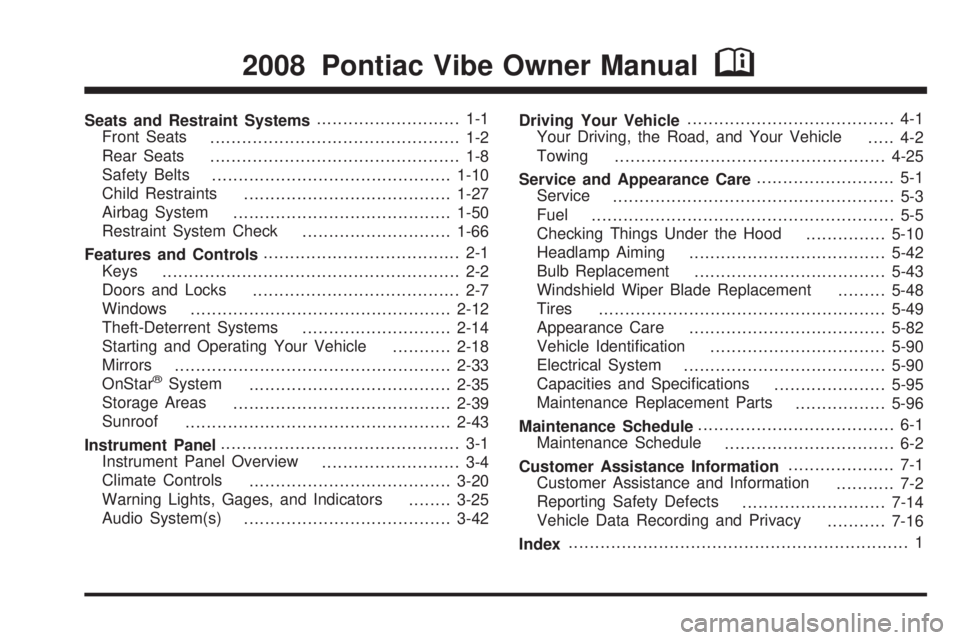
Seats and Restraint Systems........................... 1-1
Front Seats
............................................... 1-2
Rear Seats
............................................... 1-8
Safety Belts
.............................................1-10
Child Restraints
.......................................1-27
Airbag System
.........................................1-50
Restraint System Check
............................1-66
Features and Controls..................................... 2-1
Keys
........................................................ 2-2
Doors and Locks
....................................... 2-7
Windows
.................................................2-12
Theft-Deterrent Systems
............................2-14
Starting and Operating Your Vehicle
...........2-18
Mirrors
....................................................2-33
OnStar
®System
......................................2-35
Storage Areas
.........................................2-39
Sunroof
..................................................2-43
Instrument Panel............................................. 3-1
Instrument Panel Overview
.......................... 3-4
Climate Controls
......................................3-20
Warning Lights, Gages, and Indicators
........3-25
Audio System(s)
.......................................3-42Driving Your Vehicle....................................... 4-1
Your Driving, the Road, and Your Vehicle
..... 4-2
Towing
...................................................4-25
Service and Appearance Care.......................... 5-1
Service
..................................................... 5-3
Fuel
......................................................... 5-5
Checking Things Under the Hood
...............5-10
Headlamp Aiming
.....................................5-42
Bulb Replacement
....................................5-43
Windshield Wiper Blade Replacement
.........5-48
Tires
......................................................5-49
Appearance Care
.....................................5-82
Vehicle Identi�cation
.................................5-90
Electrical System
......................................5-90
Capacities and Speci�cations
.....................5-95
Maintenance Replacement Parts
.................5-96
Maintenance Schedule..................................... 6-1
Maintenance Schedule
................................ 6-2
Customer Assistance Information.................... 7-1
Customer Assistance and Information
........... 7-2
Reporting Safety Defects
...........................7-14
Vehicle Data Recording and Privacy
...........7-16
Index................................................................ 1
2008 Pontiac Vibe Owner ManualM
Page 82 of 368
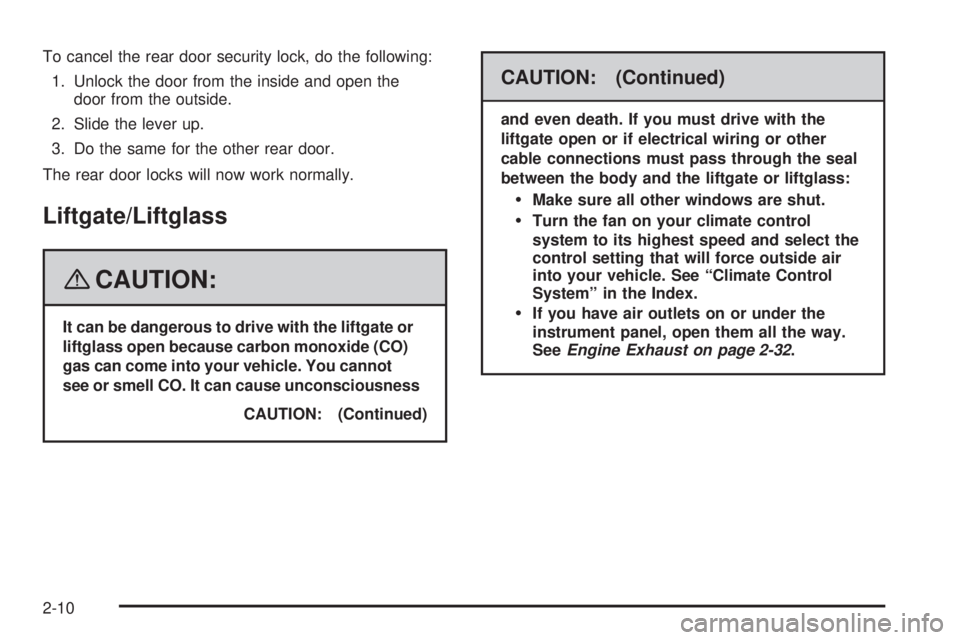
To cancel the rear door security lock, do the following:
1. Unlock the door from the inside and open the
door from the outside.
2. Slide the lever up.
3. Do the same for the other rear door.
The rear door locks will now work normally.
Liftgate/Liftglass
{CAUTION:
It can be dangerous to drive with the liftgate or
liftglass open because carbon monoxide (CO)
gas can come into your vehicle. You cannot
see or smell CO. It can cause unconsciousness
CAUTION: (Continued)
CAUTION: (Continued)
and even death. If you must drive with the
liftgate open or if electrical wiring or other
cable connections must pass through the seal
between the body and the liftgate or liftglass:
Make sure all other windows are shut.
Turn the fan on your climate control
system to its highest speed and select the
control setting that will force outside air
into your vehicle. See “Climate Control
System” in the Index.
If you have air outlets on or under the
instrument panel, open them all the way.
SeeEngine Exhaust on page 2-32.
2-10
Page 104 of 368
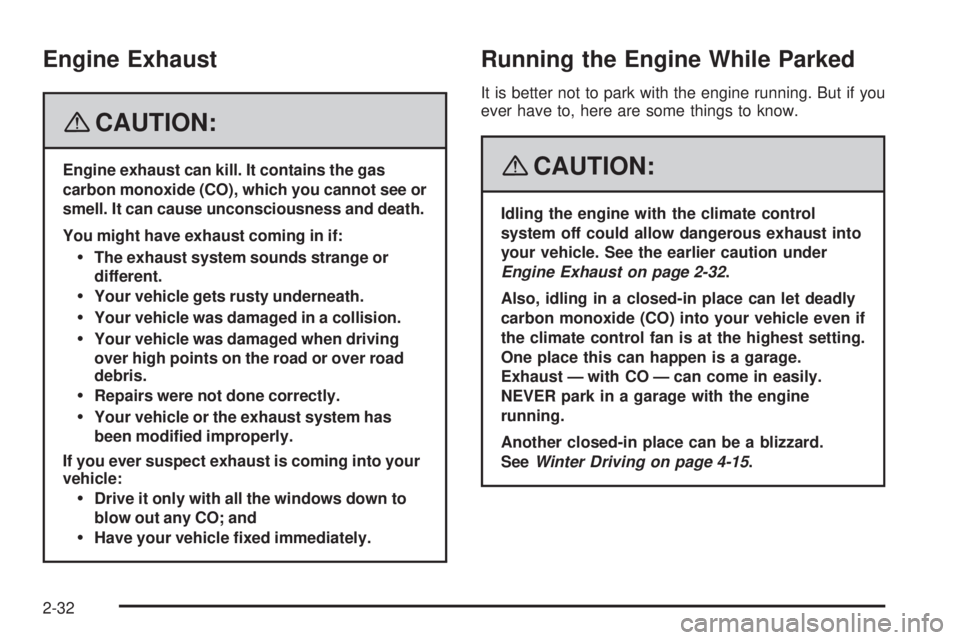
Engine Exhaust
{CAUTION:
Engine exhaust can kill. It contains the gas
carbon monoxide (CO), which you cannot see or
smell. It can cause unconsciousness and death.
You might have exhaust coming in if:
The exhaust system sounds strange or
different.
Your vehicle gets rusty underneath.
Your vehicle was damaged in a collision.
Your vehicle was damaged when driving
over high points on the road or over road
debris.
Repairs were not done correctly.
Your vehicle or the exhaust system has
been modi�ed improperly.
If you ever suspect exhaust is coming into your
vehicle:
Drive it only with all the windows down to
blow out any CO; and
Have your vehicle �xed immediately.
Running the Engine While Parked
It is better not to park with the engine running. But if you
ever have to, here are some things to know.
{CAUTION:
Idling the engine with the climate control
system off could allow dangerous exhaust into
your vehicle. See the earlier caution under
Engine Exhaust on page 2-32.
Also, idling in a closed-in place can let deadly
carbon monoxide (CO) into your vehicle even if
the climate control fan is at the highest setting.
One place this can happen is a garage.
Exhaust — with CO — can come in easily.
NEVER park in a garage with the engine
running.
Another closed-in place can be a blizzard.
SeeWinter Driving on page 4-15.
2-32
Page 117 of 368
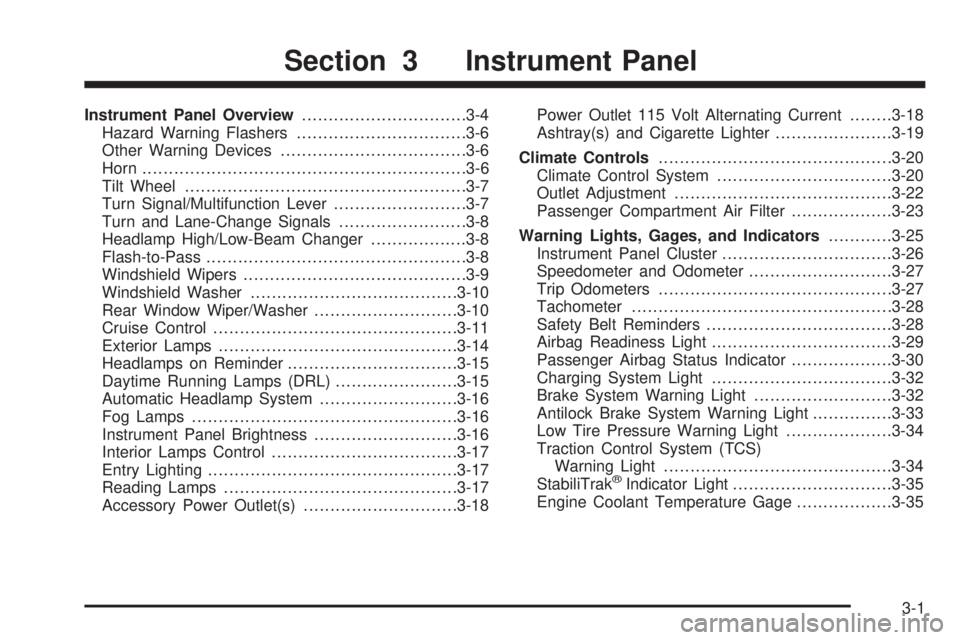
Instrument Panel Overview...............................3-4
Hazard Warning Flashers................................3-6
Other Warning Devices...................................3-6
Horn.............................................................3-6
Tilt Wheel.....................................................3-7
Turn Signal/Multifunction Lever.........................3-7
Turn and Lane-Change Signals........................3-8
Headlamp High/Low-Beam Changer..................3-8
Flash-to-Pass.................................................3-8
Windshield Wipers..........................................3-9
Windshield Washer.......................................3-10
Rear Window Wiper/Washer...........................3-10
Cruise Control..............................................3-11
Exterior Lamps.............................................3-14
Headlamps on Reminder................................3-15
Daytime Running Lamps (DRL).......................3-15
Automatic Headlamp System..........................3-16
Fog Lamps..................................................3-16
Instrument Panel Brightness...........................3-16
Interior Lamps Control...................................3-17
Entry Lighting...............................................3-17
Reading Lamps............................................3-17
Accessory Power Outlet(s).............................3-18Power Outlet 115 Volt Alternating Current........3-18
Ashtray(s) and Cigarette Lighter......................3-19
Climate Controls............................................3-20
Climate Control System.................................3-20
Outlet Adjustment.........................................3-22
Passenger Compartment Air Filter...................3-23
Warning Lights, Gages, and Indicators............3-25
Instrument Panel Cluster................................3-26
Speedometer and Odometer...........................3-27
Trip Odometers............................................3-27
Tachometer................................................
.3-28
Safety Belt Reminders...................................3-28
Airbag Readiness Light..................................3-29
Passenger Airbag Status Indicator...................3-30
Charging System Light..................................3-32
Brake System Warning Light..........................3-32
Antilock Brake System Warning Light...............3-33
Low Tire Pressure Warning Light....................3-34
Traction Control System (TCS)
Warning Light...........................................3-34
StabiliTrak
®Indicator Light..............................3-35
Engine Coolant Temperature Gage..................3-35
Section 3 Instrument Panel
3-1
Page 121 of 368
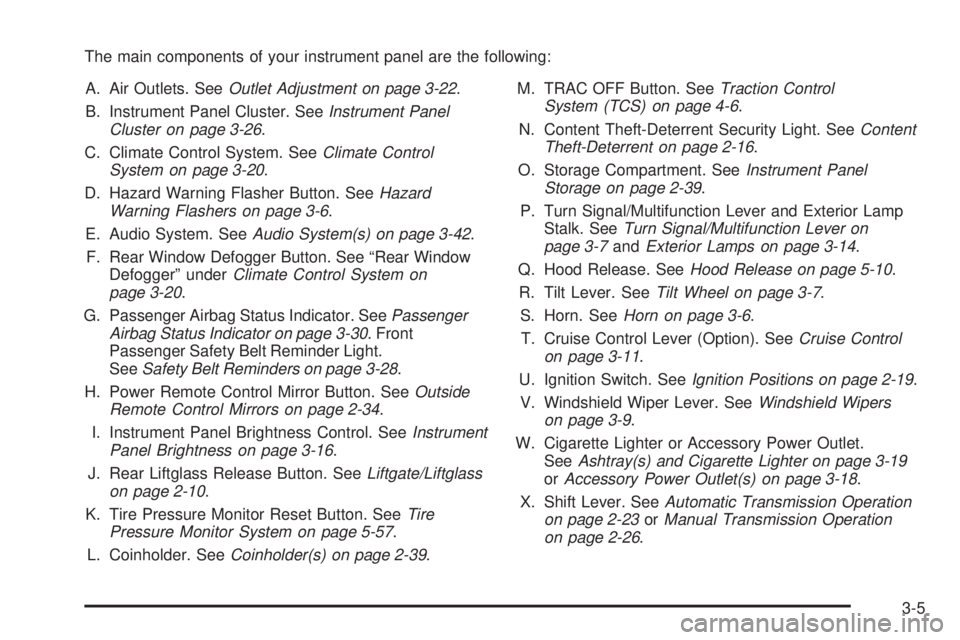
The main components of your instrument panel are the following:
A. Air Outlets. SeeOutlet Adjustment on page 3-22.
B. Instrument Panel Cluster. SeeInstrument Panel
Cluster on page 3-26.
C. Climate Control System. SeeClimate Control
System on page 3-20.
D. Hazard Warning Flasher Button. SeeHazard
Warning Flashers on page 3-6.
E. Audio System. SeeAudio System(s) on page 3-42.
F. Rear Window Defogger Button. See “Rear Window
Defogger” underClimate Control System on
page 3-20.
G. Passenger Airbag Status Indicator. SeePassenger
Airbag Status Indicator on page 3-30. Front
Passenger Safety Belt Reminder Light.
SeeSafety Belt Reminders on page 3-28.
H. Power Remote Control Mirror Button. SeeOutside
Remote Control Mirrors on page 2-34.
I. Instrument Panel Brightness Control. SeeInstrument
Panel Brightness on page 3-16.
J. Rear Liftglass Release Button. SeeLiftgate/Liftglass
on page 2-10.
K. Tire Pressure Monitor Reset Button. SeeTire
Pressure Monitor System on page 5-57.
L. Coinholder. SeeCoinholder(s) on page 2-39.M. TRAC OFF Button. SeeTraction Control
System (TCS) on page 4-6.
N. Content Theft-Deterrent Security Light. SeeContent
Theft-Deterrent on page 2-16.
O. Storage Compartment. SeeInstrument Panel
Storage on page 2-39.
P. Turn Signal/Multifunction Lever and Exterior Lamp
Stalk. SeeTurn Signal/Multifunction Lever on
page 3-7andExterior Lamps on page 3-14.
Q. Hood Release. SeeHood Release on page 5-10.
R. Tilt Lever. SeeTilt Wheel on page 3-7.
S. Horn. SeeHorn on page 3-6.
T. Cruise Control Lever (Option). SeeCruise Control
on page 3-11.
U. Ignition Switch. SeeIgnition Positions on page 2-19.
V. Windshield Wiper Lever. SeeWindshield Wipers
on page 3-9.
W. Cigarette Lighter or Accessory Power Outlet.
SeeAshtray(s) and Cigarette Lighter on page 3-19
orAccessory Power Outlet(s) on page 3-18.
X. Shift Lever. SeeAutomatic Transmission Operation
on page 2-23orManual Transmission Operation
on page 2-26
.
3-5
Page 134 of 368
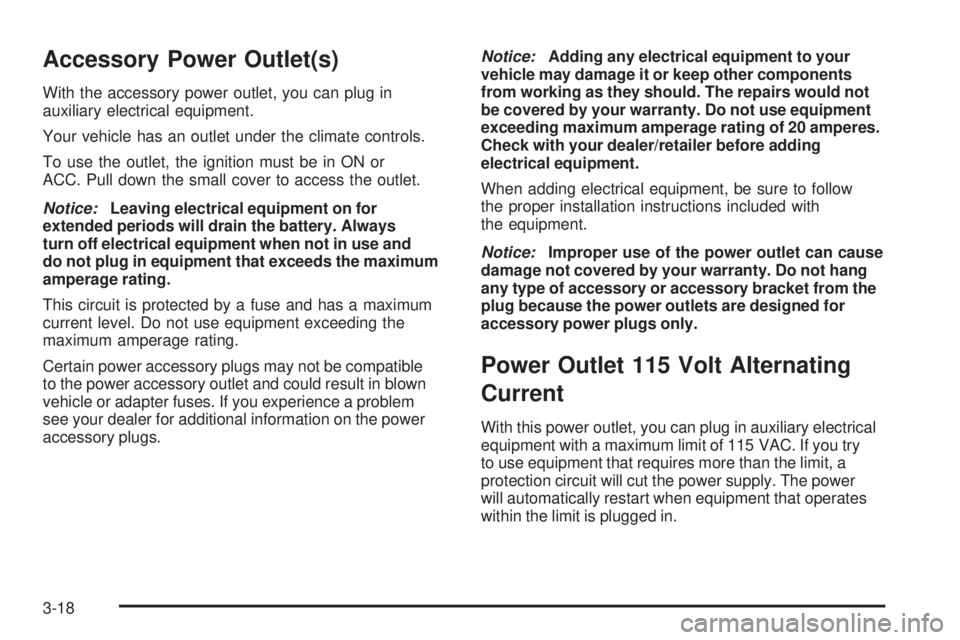
Accessory Power Outlet(s)
With the accessory power outlet, you can plug in
auxiliary electrical equipment.
Your vehicle has an outlet under the climate controls.
To use the outlet, the ignition must be in ON or
ACC. Pull down the small cover to access the outlet.
Notice:Leaving electrical equipment on for
extended periods will drain the battery. Always
turn off electrical equipment when not in use and
do not plug in equipment that exceeds the maximum
amperage rating.
This circuit is protected by a fuse and has a maximum
current level. Do not use equipment exceeding the
maximum amperage rating.
Certain power accessory plugs may not be compatible
to the power accessory outlet and could result in blown
vehicle or adapter fuses. If you experience a problem
see your dealer for additional information on the power
accessory plugs.Notice:Adding any electrical equipment to your
vehicle may damage it or keep other components
from working as they should. The repairs would not
be covered by your warranty. Do not use equipment
exceeding maximum amperage rating of 20 amperes.
Check with your dealer/retailer before adding
electrical equipment.
When adding electrical equipment, be sure to follow
the proper installation instructions included with
the equipment.
Notice:Improper use of the power outlet can cause
damage not covered by your warranty. Do not hang
any type of accessory or accessory bracket from the
plug because the power outlets are designed for
accessory power plugs only.
Power Outlet 115 Volt Alternating
Current
With this power outlet, you can plug in auxiliary electrical
equipment with a maximum limit of 115 VAC. If you try
to use equipment that requires more than the limit, a
protection circuit will cut the power supply. The power
will automatically restart when equipment that operates
within the limit is plugged in.
3-18
Page 136 of 368
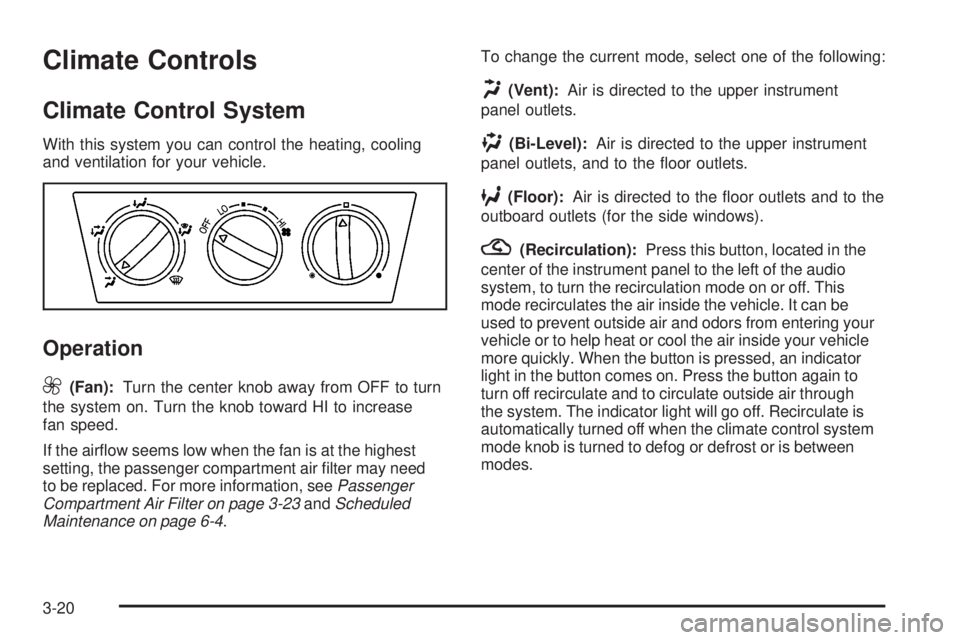
Climate Controls
Climate Control System
With this system you can control the heating, cooling
and ventilation for your vehicle.
Operation
9
(Fan):Turn the center knob away from OFF to turn
the system on. Turn the knob toward HI to increase
fan speed.
If the air�ow seems low when the fan is at the highest
setting, the passenger compartment air �lter may need
to be replaced. For more information, seePassenger
Compartment Air Filter on page 3-23andScheduled
Maintenance on page 6-4.To change the current mode, select one of the following:
H(Vent):Air is directed to the upper instrument
panel outlets.
)(Bi-Level):Air is directed to the upper instrument
panel outlets, and to the �oor outlets.
6(Floor):Air is directed to the �oor outlets and to the
outboard outlets (for the side windows).
?(Recirculation):Press this button, located in the
center of the instrument panel to the left of the audio
system, to turn the recirculation mode on or off. This
mode recirculates the air inside the vehicle. It can be
used to prevent outside air and odors from entering your
vehicle or to help heat or cool the air inside your vehicle
more quickly. When the button is pressed, an indicator
light in the button comes on. Press the button again to
turn off recirculate and to circulate outside air through
the system. The indicator light will go off. Recirculate is
automatically turned off when the climate control system
mode knob is turned to defog or defrost or is between
modes.
3-20
Page 137 of 368
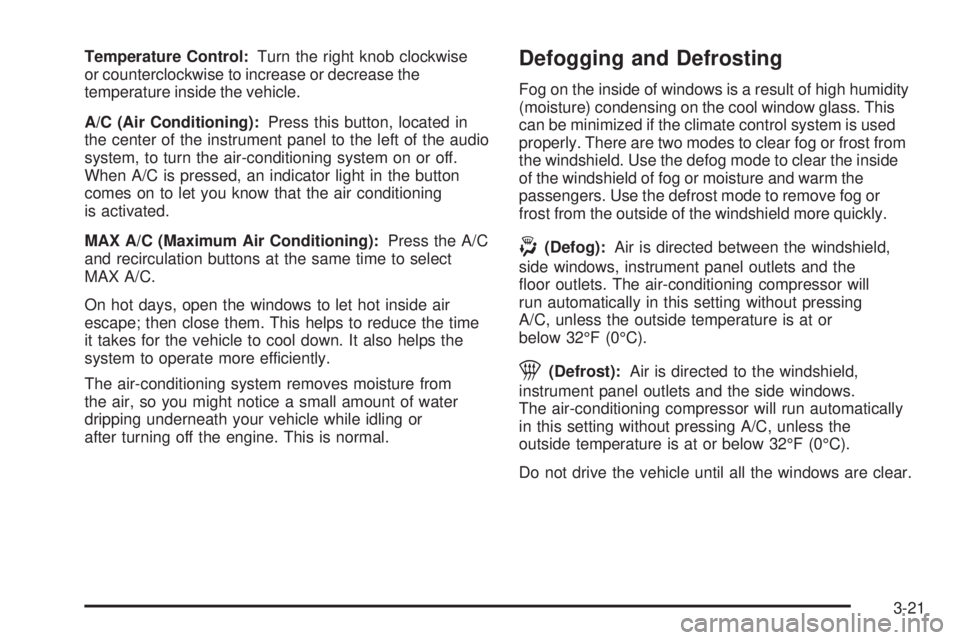
Temperature Control:Turn the right knob clockwise
or counterclockwise to increase or decrease the
temperature inside the vehicle.
A/C (Air Conditioning):Press this button, located in
the center of the instrument panel to the left of the audio
system, to turn the air-conditioning system on or off.
When A/C is pressed, an indicator light in the button
comes on to let you know that the air conditioning
is activated.
MAX A/C (Maximum Air Conditioning):Press the A/C
and recirculation buttons at the same time to select
MAX A/C.
On hot days, open the windows to let hot inside air
escape; then close them. This helps to reduce the time
it takes for the vehicle to cool down. It also helps the
system to operate more efficiently.
The air-conditioning system removes moisture from
the air, so you might notice a small amount of water
dripping underneath your vehicle while idling or
after turning off the engine. This is normal.Defogging and Defrosting
Fog on the inside of windows is a result of high humidity
(moisture) condensing on the cool window glass. This
can be minimized if the climate control system is used
properly. There are two modes to clear fog or frost from
the windshield. Use the defog mode to clear the inside
of the windshield of fog or moisture and warm the
passengers. Use the defrost mode to remove fog or
frost from the outside of the windshield more quickly.
-(Defog):Air is directed between the windshield,
side windows, instrument panel outlets and the
�oor outlets. The air-conditioning compressor will
run automatically in this setting without pressing
A/C, unless the outside temperature is at or
below 32°F (0°C).
1(Defrost):Air is directed to the windshield,
instrument panel outlets and the side windows.
The air-conditioning compressor will run automatically
in this setting without pressing A/C, unless the
outside temperature is at or below 32°F (0°C).
Do not drive the vehicle until all the windows are clear.
3-21
Page 280 of 368
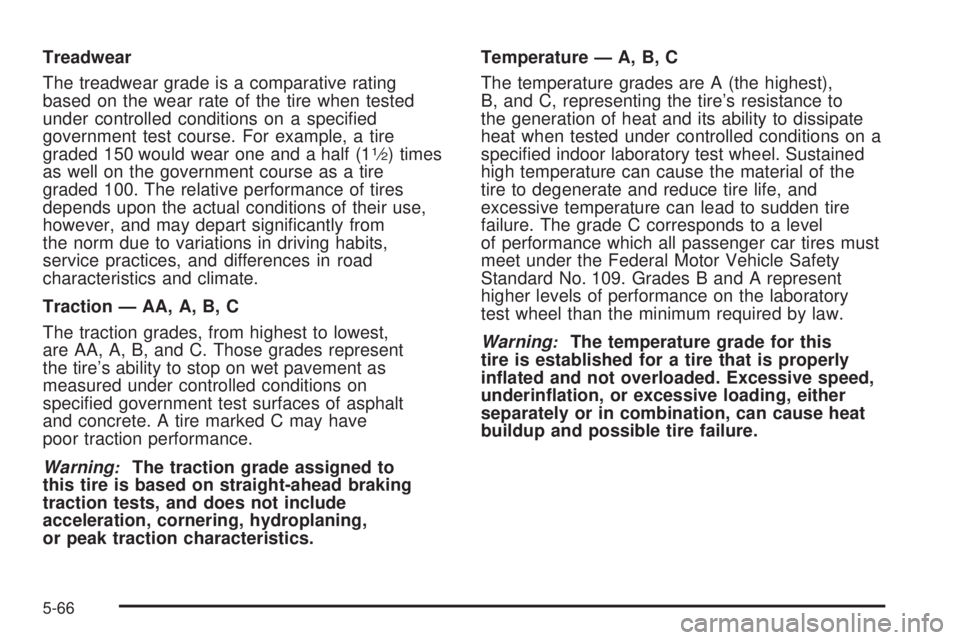
Treadwear
The treadwear grade is a comparative rating
based on the wear rate of the tire when tested
under controlled conditions on a speci�ed
government test course. For example, a tire
graded 150 would wear one and a half (1
1�2) times
as well on the government course as a tire
graded 100. The relative performance of tires
depends upon the actual conditions of their use,
however, and may depart signi�cantly from
the norm due to variations in driving habits,
service practices, and differences in road
characteristics and climate.
Traction — AA, A, B, C
The traction grades, from highest to lowest,
are AA, A, B, and C. Those grades represent
the tire’s ability to stop on wet pavement as
measured under controlled conditions on
speci�ed government test surfaces of asphalt
and concrete. A tire marked C may have
poor traction performance.
Warning
:The traction grade assigned to
this tire is based on straight-ahead braking
traction tests, and does not include
acceleration, cornering, hydroplaning,
or peak traction characteristics.Temperature — A, B, C
The temperature grades are A (the highest),
B, and C, representing the tire’s resistance to
the generation of heat and its ability to dissipate
heat when tested under controlled conditions on a
speci�ed indoor laboratory test wheel. Sustained
high temperature can cause the material of the
tire to degenerate and reduce tire life, and
excessive temperature can lead to sudden tire
failure. The grade C corresponds to a level
of performance which all passenger car tires must
meet under the Federal Motor Vehicle Safety
Standard No. 109. Grades B and A represent
higher levels of performance on the laboratory
test wheel than the minimum required by law.
Warning
:The temperature grade for this
tire is established for a tire that is properly
in�ated and not overloaded. Excessive speed,
underin�ation, or excessive loading, either
separately or in combination, can cause heat
buildup and possible tire failure.
5-66
Page 357 of 368
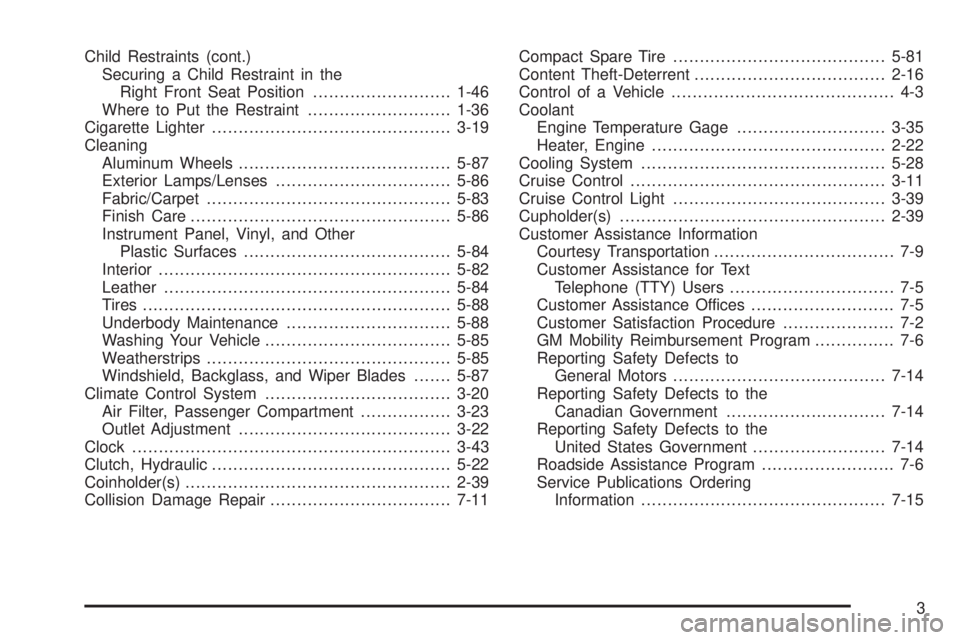
Child Restraints (cont.)
Securing a Child Restraint in the
Right Front Seat Position..........................1-46
Where to Put the Restraint...........................1-36
Cigarette Lighter.............................................3-19
Cleaning
Aluminum Wheels........................................5-87
Exterior Lamps/Lenses.................................5-86
Fabric/Carpet..............................................5-83
Finish Care.................................................5-86
Instrument Panel, Vinyl, and Other
Plastic Surfaces.......................................5-84
Interior.......................................................5-82
Leather......................................................5-84
Tires..........................................................5-88
Underbody Maintenance...............................5-88
Washing Your Vehicle...................................5-85
Weatherstrips..............................................5-85
Windshield, Backglass, and Wiper Blades.......5-87
Climate Control System...................................3-20
Air Filter, Passenger Compartment.................3-23
Outlet Adjustment........................................3-22
Clock............................................................3-43
Clutch, Hydraulic.............................................5-22
Coinholder(s)..................................................2-39
Collision Damage Repair..................................7-11Compact Spare Tire........................................5-81
Content Theft-Deterrent....................................2-16
Control of a Vehicle.......................................... 4-3
Coolant
Engine Temperature Gage............................3-35
Heater, Engine............................................2-22
Cooling System..............................................5-28
Cruise Control................................................3-11
Cruise Control Light........................................3-39
Cupholder(s)..................................................2-39
Customer Assistance Information
Courtesy Transportation.................................. 7-9
Customer Assistance for Text
Telephone (TTY) Users............................... 7-5
Customer Assistance Offices........................... 7-5
Customer Satisfaction Procedure..................... 7-2
GM Mobility Reimbursement Program............... 7-6
Reporting Safety Defects to
General Motors........................................7-14
Reporting Safety Defects to the
Canadian Government..............................7-14
Reporting Safety Defects to the
United States Government.........................7-14
Roadside Assistance Program......................... 7-6
Service Publications Ordering
Information..............................................7-15
3